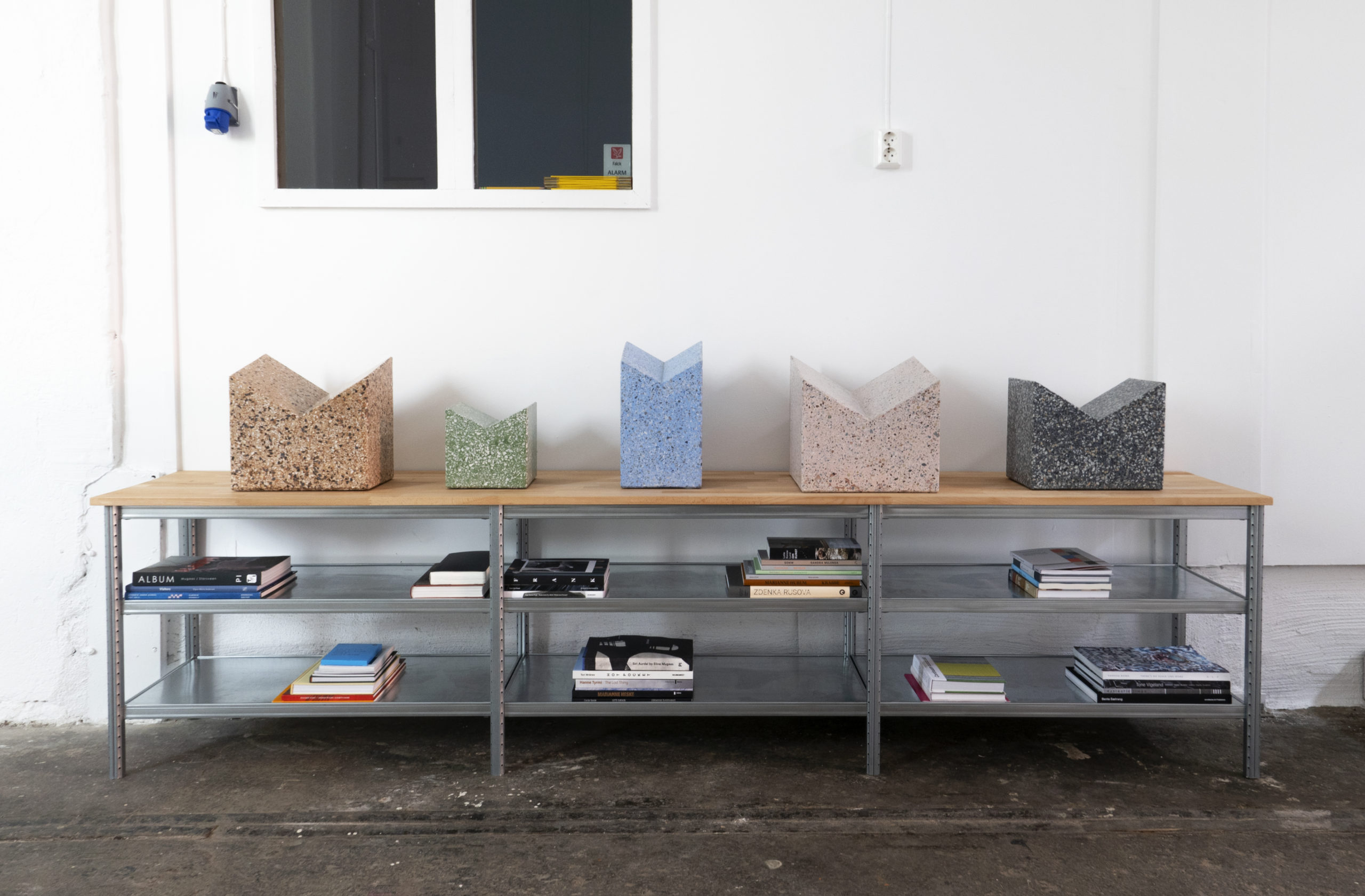
The Supporter and the Supported
Eline Mugaas overturns established hierarchies in her practice. Support structures that we wouldn’t notice ordinarily, but which are completely essential for making something else visible or allowing it to function, get to play the main role in the artist’s work
Five terazzo bookrests in green, pink, brown, blue, and gray are displayed on a low, sturdy, steel shelf. The bookrests are sculptures. Variations in shape, color, and stone pattern give each of them a unique character. They are heavy and they are also made for displaying books. When an opened book is placed on one of the bookrests, parts of the sculpture are no longer visible, but as a bookrest, it now fulfils its function as an object made to support and present something else. This duality between sculpture and functional object is something artist Eline Mugaas plays on deliberately.
On the shelf beneath the sculptures lie stacks of books by and about a range of artists. These books have been purchased by Mugaas for a nascent art library at the Norwegian embassy in Washington, D.C. She says of her selection:
– The bookshelf will be allowed to evolve and change over time. It’s okay if people swap which books are lying open, the ones displayed on the bookrests. And there’s room for more books. All the books I purchased are by or about artists connected to the Norwegian art scene. This is somewhat limiting, because there are many artists who haven’t had a book made about them yet. Future employees of the embassy may perhaps have interests that are completely different from mine – and there’s space for their books too.
Together the five bookrests form a colorful group in terrazzo. Terrazzo is a material that is often used for floors and stairs in public buildings – in surfaces that must withstand heavy wear. Mugaas has been interested in the material for several years, collecting images of terrazzo floors. In her new works, she draws our attention to terrazzo as an actual art material.
– I think it’s interesting to disrupt hierarchical notions about materials, what’s thought of as an art material and what’s really made for flooring. The bookrests would have been something completely different if they had been made of marble, for example.
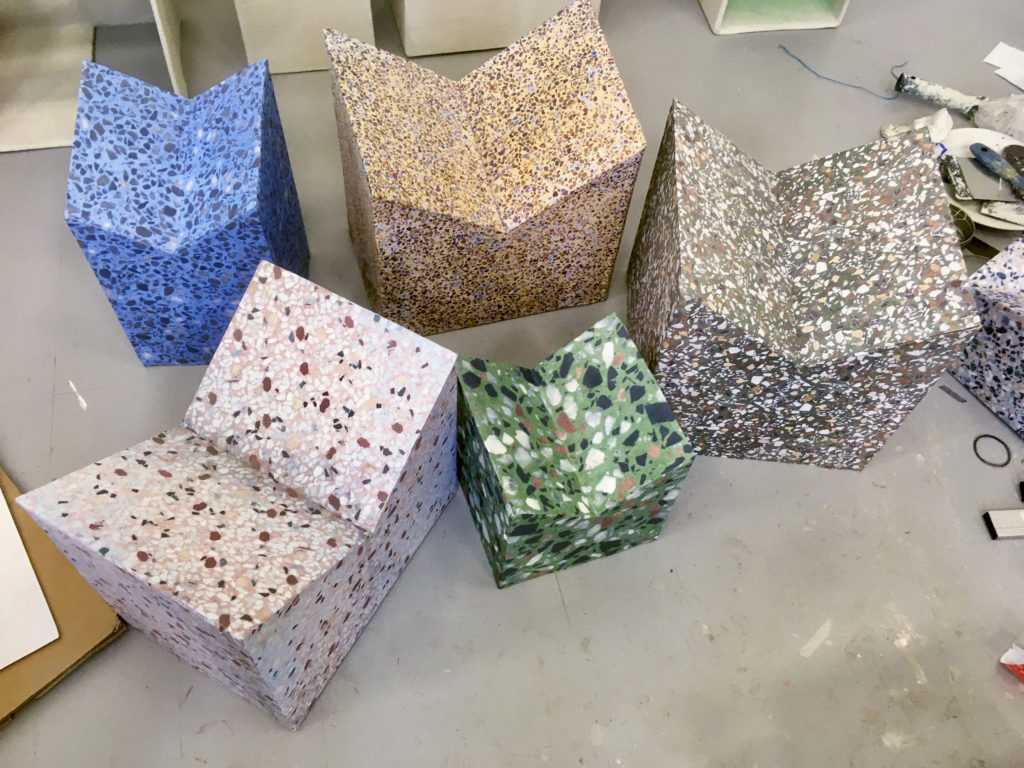
By creating art from an industrial flooring material, the artist alters conventional conceptions about what art is and what constitutes an “autonomous art object.” The ordinary, everyday material terrazzo, contributes to emphasizing an ambivalence in the sculptures: they both resemble and actually are bookrests. Accordingly, they switch between being objects of art and of utility.
To put it another way, Mugaas overturns established hierarchies in her practice. Support structures that we wouldn’t notice ordinarily, but which are completely essential for making something else visible or allowing it to function, get to play the main role in the artist’s work.
– For some time now I’ve been working on the relationships between objects. I’m interested in the transitions of hierarchies, of what supports and what is being displayed, and I try to make visible the system that exists beneath every elevated object. I want to remind the viewer that the object that you see standing seemingly alone, never exists independently but is part of a larger context. It’s about how things actually come into existence, about the fact that things cannot exist in isolation from the things that they are built on. And so, the objects I work with become an image of what is needed in order for anything to get any attention at all. What happens when something is put into a golden frame, for example? It is given value precisely because the golden frame is an obvious signifier that something is worth being valued. In other words, it’s something that’s worth being framed in gold.
Mugaas points to the design of bookrests and other display structures, and wants us to become more aware of their specific histories and contexts:
– I’ve been collecting visual material relating to how museums and libraries display their old, fragile books. When I’d travel in recent years, I would study the different cases and boxes people use for this purpose, in all sorts of strange places. The way books are mounted and displayed has a connection with pedestals in sculpture, and how one uses a pedestal to elevate other objects both in art exhibitions and in ethnographic and historical exhibitions – namely to secure something valuable, to lock something in place and to make sure that visitors view the object from the desired angle.
A powerful source of inspiration for Mugaas’s efforts to direct our attention towards the pedestal and supporting structures is one of the most influential artists of the twentieth century, the Modernist pioneer and sculptor Constantin Brancusi.
– I’ve had a relationship to Brancusi’s sculptures since I was young. He was important in the discussion around the “autonomous art object” and what gives it prominence. His art does not stop with the objects he made, he put just as much work into the pedestals themselves. They could just as well have been exhibited on their own – as sculptures in their own right.
He created a stage for himself and treated his atelier like a landscape. The blocks of stone that would become sculptures were just as important as those that were in the process of becoming or had already become finished works. The plinths were just as important as the sculptures.
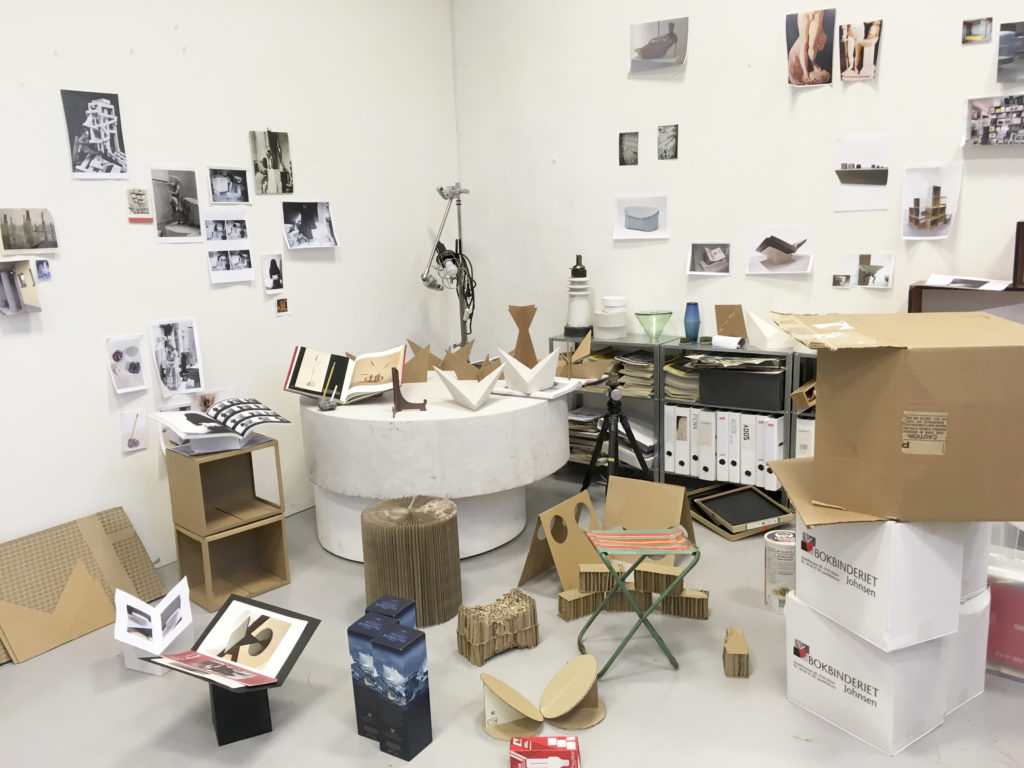
– I’ve had a relationship to Brancusi’s sculptures since I was young. He was important in the discussion around the “autonomous art object” and what gives it prominence. His art does not stop with the objects he made, he put just as much work into the pedestals themselves.
Photo: Eline Mugaas
In spring 1989, the Museum of Modern Art (MoMA) in New York held an exhibition titled “Artist’s Choice: Burton on Brancusi.” Scott Burton’s exhibition about Brancusi was the first in a series of exhibitions in which artists were invited to select, juxtapose and comment on works from MoMA’s collection. At the time, a MoMA curator said: “We have to recognize that a crucial part of the modern tradition is the creative response of artists to the works of their peers and predecessors.” Mugaas describes her relationship to both Burton and Brancusi:
– I had seen Burton’s sculptures in the early 1990s without being particularly aware that they were his. Some stood in spaces open to the public in New York City’s business district. Later on, I found out that he had assembled the first “Artist’s Choice” exhibition at MoMA, in the spring of 1989, which had consisted almost exclusively of Brancusi pedestals. That was the spring before Burton died, and just before I began my studies at the Cooper Union School of Art, in New York City. These Brancusi pedestals were something that we came back to continually during my first years as a student – and I think that must have been because my tutors had probably seen the exhibition and were intrigued about how Burton drew attention to this aspect of Brancusi’s work.
– A few years ago, I made a book support to hold the small pamphlet from that exhibition. Even though I only learned of it in hindsight, the Burton–Brancusi exhibition has been interesting to me, because it tells me something about my own position within a series of events, about what foundations I rest on; where I derive things from.
Mugaas’s bookrests grew out of a larger project that the artist has been working on for several years, where she investigates how types of labor that have been associated with women traditionally, constitute supportive functions within our society. In her work, the artist has particularly focused on the acts of lifting and carrying (of children, food, water, etc.) linked to housework and the maintenance of everyday life. In 2019, she won the prestigious Lorck Schive Art Prize for her exhibition “Nødvendigheten
av leddsetninger” (“The Necessity of Dependent Clauses”). Translated literally from Norwegian, “leddsetninger” means “joint sentences.” The word reflects how a joint (“ledd”) links two components together. This differs from the English term “dependent clauses,” which suggests something that is dependent, secondary, or subordinate. The exhibition consisted of sculptures made from old book boxes, films of a woman attempting to balance a box on her head, and a number of postcards of seats, sculptures, and architectonic elements. All the works in the exhibition thematized or drew attention to supporting structures of various types.
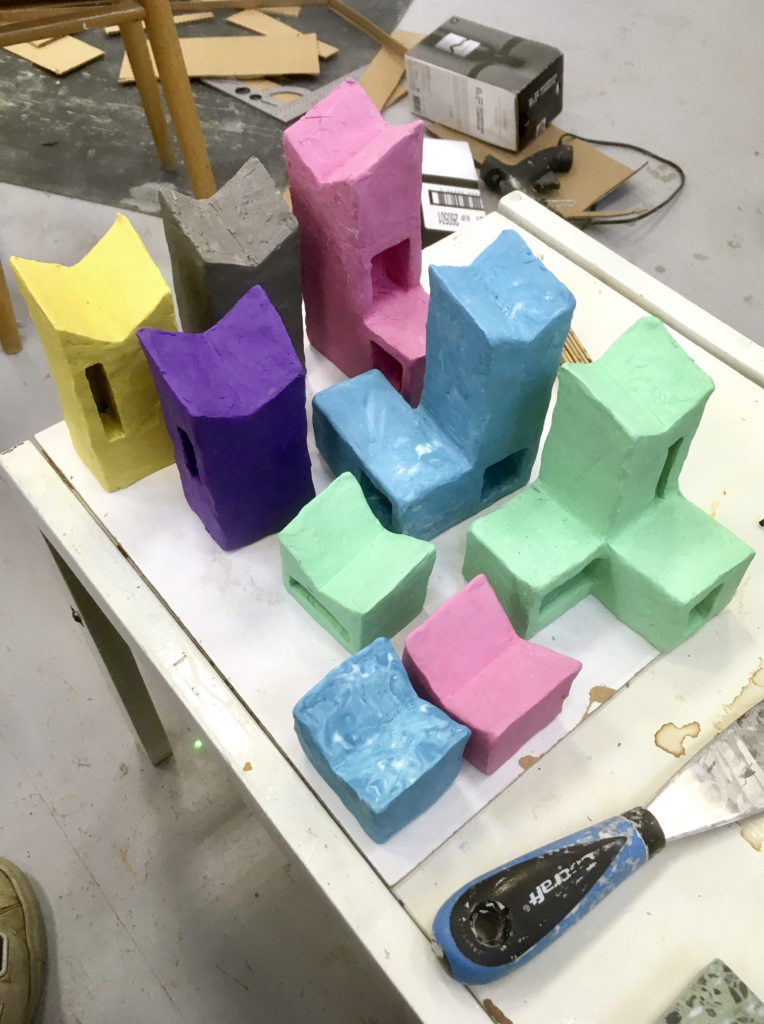
Could you say a little about your thoughts on something being necessary, and on the supporting structures that you call attention to in your work?
– Necessity has to do with meaning. I’ve always defined myself on the basis of what I’ve made, right since I was a child. The title “The Necessity of Dependent Clauses” came about because I’m interested in the precise idea that one builds something complex out of something that in itself cannot stand alone. The words “joint clauses” gave me a concrete image of the joints of the human body – like an elbow, an arm that is carrying something, a dancer’s arm being raised. This flexibility allows more rigid structures to be bound together, it makes a flatter hierarchy. Necessity says something about how something is precarious.
Over the last decade, Mugaas has also worked purposefully to draw public attention to the artistic career of an older female colleague – Siri Aurdal. Her efforts resulted, among other things, in a two-person exhibition and a publication, and led to her continuing interest in supporting structures – in things which in one context make something else possible and visible, but are seldom visible themselves.
– Working with Aurdal I have investigated what it means as an artist to use my time, my gaze, my energy, and my networks to call attention to someone else’s work. It has given me an inside experience of being a support structure, something that is expected to be invisible. And the fact that I didn’t make myself invisible was perceived by some as contaminating the interpretation of Aurdal’s artistic practice. As an artist I took on a role that did not fit with a non-contextual approach to art history and canon.
– What or whom is it that’s doing the lifting, and who is being lifted? And when does something become invisible, or become superfluous? It has been essential for me to continue to work on this theme. Is there any way to bestow equal status on what is on display and the display mechanism, namely the person or the object that is holding it up? I see it as an impossible task, for as soon as you put something on a pedestal, for example, the pedestal subsides. A support apparatus is by its very nature not intended to be seen, to draw attention to itself. But is something unnecessary just because you don’t see it? It turns out at closer inspection that you can’t remove the support.
– This point about invisibility also has much larger implications. These are linked to the struggle for women’s rights, the struggle against the continual concealment of the structures and networks that are at play. Like the idea that when you succeed as an artist, what you have accomplished you have done all on your own. This is an illusion, of course. In addition, it conceals those factors that have enabled male artists to make their breakthroughs, and which have made it difficult for many female artists to do the same, because they have often stood outside the system – outside the network.
– By directing your gaze at something, you give it visibility and value, and as an artist that is one of the tools you work with. When you move your gaze from your own work to that of another artist, it becomes obvious what weight this gaze has. There is a line in this social game between being self-confident – having faith in your own project – and appearing to be crassly self-promoting. And my experience is that this line is drawn much sooner for women than it is for men.
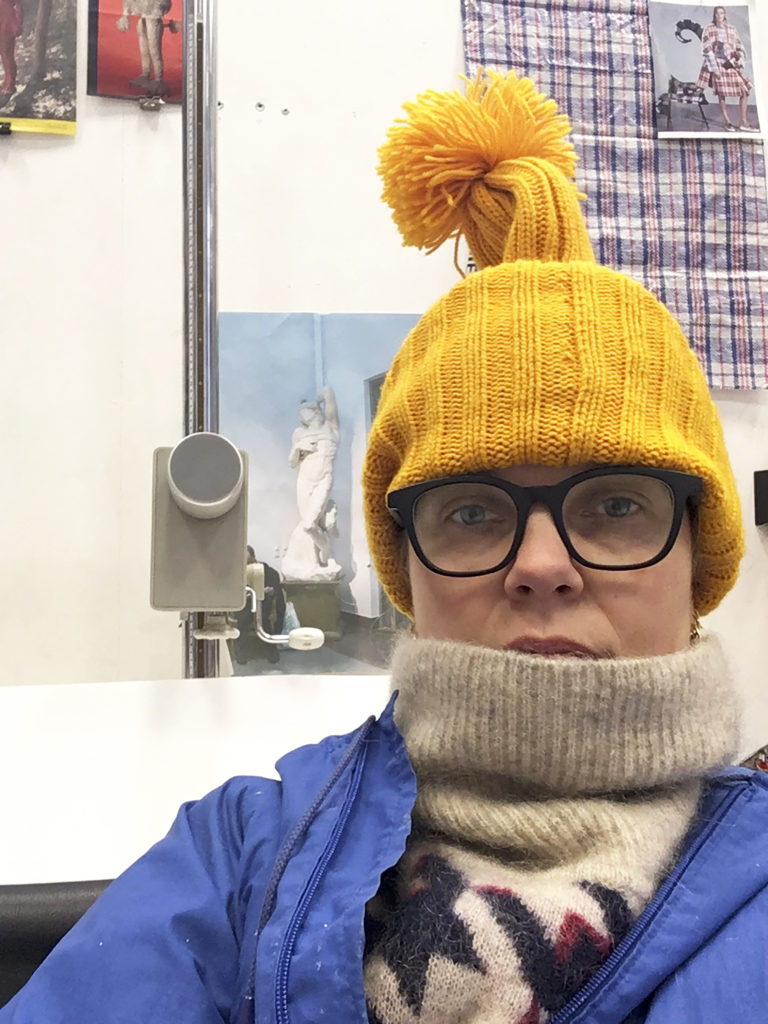
Another foundation for the bookrest sculptures is Mugaas’s long history of working with books.
– I’ve been making books for a while. Books that are artworks in their own right, books about my work, and a book about another artist. With that book I became someone who was carrying someone else. All of this went into the bookrests, but there is also a practical part in that I want to see a book as an art object in itself. The Aurdal book, for example, was wrongly received as a catalogue, which made me interested in drawing attention to it as an art object and including it in shows in various ways. First, I took four or five copies and allowed them to lie open at different pages. Subsequently, I made a project based on the cardboard boxes in which the books about Aurdal arrived from the printer’s, and which were lying around in my studio – they became the sculptures in “The Necessity of Dependent Clauses.”
Mugaas, who lives with dyslexia, finds other ways of communicating than through text. Factors such as a book’s size and weight can communicate just as powerfully as words that something is important; that a story is worth pursuing further.
– I studied sculpture at art school and one thing that I’ve taken from that which is important to me, including when I make books, is the relationship between size and shape. What is an object’s inherent scale? How does scale change an object’s presence in the world? When is something experienced as large or small in relation to one’s own body?
The artist points to a conservatism on the part of art historians, who continually revert to written sources to find the “truth” about artworks and artists, but who often forget to acknowledge that much art was never documented in writing. The experience of art is first and foremost a physical encounter, a “here and now” before the work gets written about.
– One should never underestimate the physical experience: when you touch something, your fingers acquire knowledge about what you’re touching just as much as your head does. We have a mass of shared and personal experiences, and those memories sit in our bodies. When we experience art, we have these memories with us, and we read both objects and materials in their light. For instance, what does a high-quality offset print on thick paper communicate compared to an image on newsprint? What is the difference between an object in terrazzo and one made from a cheap mass-produced building material, even if some people would refer to both as “concrete?”
– As an artist, your work is to create meaning. Everyone does this of course, but artists are trained to be hyperaware of it. Art is important because it strives to articulate something about being alive right now, and it can do this by activating things we take for granted: creating mental speed bumps that make viewers aware of something they might walk past otherwise. This can be done in big or small ways, aesthetically, politically, or existentially, but it’s about experiences. For me, the delight of art is to recognize shared experiences – sometimes really small and specific ones, and sometimes over vast expanses of time. All these human experiences that one can be in contact with are part of the language of art.
***
Interview conducted by Marte Danielsen Jølbo and Pernille Skar Nordby